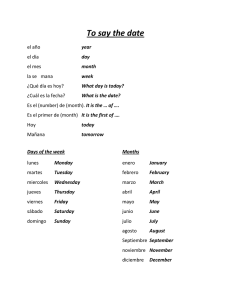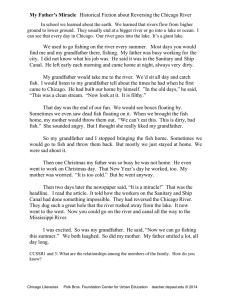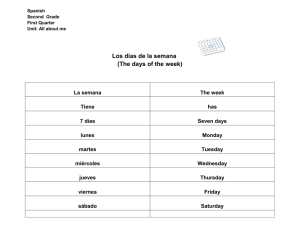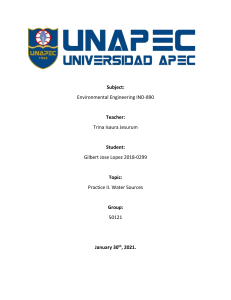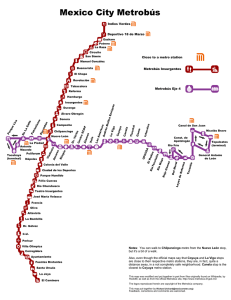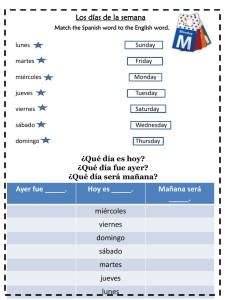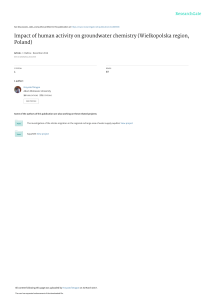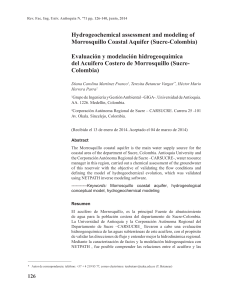Outline What is a Model?
Anuncio
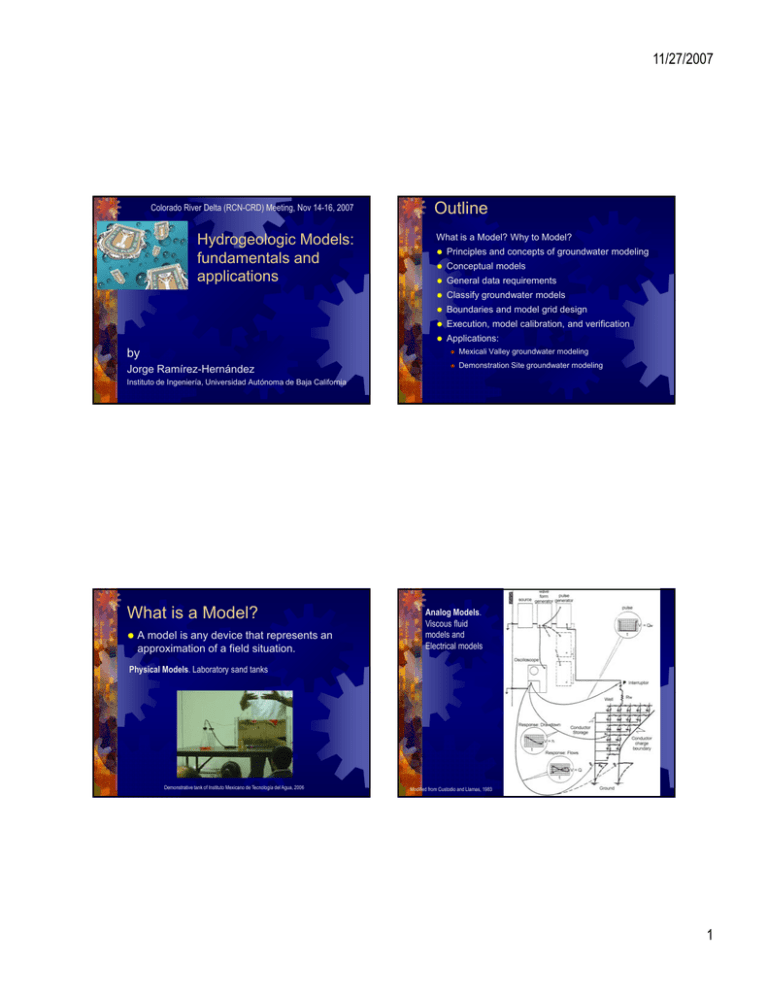
11/27/2007 Colorado River Delta (RCN-CRD) Meeting, Nov 14-16, 2007 Hydrogeologic Models: fundamentals and applications Outline What is a Model? Why to Model? Principles and concepts of groundwater modeling Conceptual models General data requirements Classifyy groundwater g models Boundaries and model grid design Execution, model calibration, and verification Applications: by Mexicali Valley groundwater modeling Jorge Ramírez-Hernández Demonstration Site groundwater modeling Instituto de Ingeniería, Universidad Autónoma de Baja California What is a Model? A model is any device that represents an approximation of a field situation. Analog Models. Viscous fluid models and Electrical models Physical Models. Laboratory sand tanks Demonstrative tank of Instituto Mexicano de Tecnología del Agua, 2006 Modified from Custodio and Llamas, 1983 1 11/27/2007 What is a Model? Mathematical Models. Simulate groundwater flow indirectly by means of a governing equation. ∂ ∂h ∂ ∂h ∂ ∂h ∂h ( K xx ) + ( K yy ) + ( K zz ) - W = S s ∂x ∂x ∂y ∂y ∂z ∂z ∂t Solution: Analytical. Very simple geometries and homogeneous porous medium. Numerical: help to solve much more complex models that are easier to apply. Why to use models? Opinions about models Disadvantages • Models require too many data and therefore are too expensive to assemble and run. • They can never be proved to be correct and suffer from a lack of scientific certainty. • They are toys which provide intellectual stimulation. Advantages • Models are essential in performing complex analyses and in making informed predictions. • They allow more effective use of available data. • One of the most valuable and practical tools. • Models are often the best available alternative for analyzing complex water resource problems. Establishing the purpose of modeling (first step) Prediction • Most groundwater modeling efforts are aimed to predict the consequences of a proposed action. Example: All american canal lining Interpretation • Models can be used in an interpretative sense to gain insight into the controlling parameters in a site-specific setting or as a framework for assembling and organizing field data and formulating ideas about system dynamics. Example: Mexicali valley groundwater dynamic Generic • Models be used to study processes in generic geologic settings. Example: lake-groundwater interaction. My goal is prediction, system interpretation, or a generic modeling exercise? What do I want to learn from the model? What question do I want the model to answer? Is a modeling exercise the best way to answer the question(s)? 2 11/27/2007 Modeling Protocol Conceptual model A conceptual model is a pictoral representation of the groundwater flow system. purpose p of conceptual p model is to The p simplify as much as possible yet retains enough complexity so that it adequately reproduce system behavoir. Block diagram Cross section Taken from Anderson and Woessner, 1992 Conceptual model Steps for building a Conceptual model Conceptual model (examples) • Define the area of interest, i.e. identify boundaries of the model. model • Define hydrostratigraphic units • Prepare a water budget • Define the flow system Taken from Anderson and Woessner, 1992 3 11/27/2007 Conceptual model (examples) 3 2 Conceptual model (examples) April 2006 Abril 2006 16 RC-M12 PERFIL 2 RC-M10 RC M10 14 HeightAltura (m) (m) Section 2. RC-M9 RC-M11 12 10.095 10 8 Flujo Subter 6 0 500 10.82 10.066 9.858 Río ráneo 1000 1500 2000 Distance (m) Distancia (km) Taken from Ramírez-Hernández, 1996 General data requirements Physical framework • • • • • Geologic map and cross sections showing areal and vertical extents of boundaries of the system. Topographic map showing surface water bodies and divides. Contour maps of elevation of the base of the aquifer and any bed. Isopach maps of thickness of aquifer and confining beds. Maps of the extent and thickness of stream and lake sediments. Hydrogeologic framework • Water table and piezometric maps. • Hydrographs of groundwater head and surface water levels and discharge rates. • Maps and cross sections of hydraulic conductivity distribution. • Maps and cross sections of storage properties of aquifer. • Hydraulic conductivity values and their distribution on stream and lake sediments. • Spatial and temporal distribution rates of evapotranspiration, groundwater recharge, surface-groundwater interaction, groundwater pumping, and natural groundwater discharge. Colorado River demonstration Site Taken from Pérez et al, 2006 Classify groundwater flow models By time dependency • Steady state. The flow will be independent of time. • Transient. The flow change with time. By aquifer type: • Confined. • Unconfined (free). Spatial dimension: • Two-dimensional areal. Flow in W-E and N-S directions. • Two-dimensional profile. Flow in horizontal and vertical directions. • Full three dimensional. Flow in W-E, N-S and Z directions. Other governing equations: • Advective transport, unsaturated flow, inmiscible flow, density effects, dispersion, flow through fractures, two-phases flow, etc. 4 11/27/2007 Ground-Water Flow equation ∂ ∂h ∂ ∂h ∂ ∂h ∂h ( K xx ) + ( K yy ) + ( K zz ) - W = S s ∂x ∂x ∂y ∂y ∂z ∂z ∂t Where: Kxx, Kyy and Kzz Hydraulic conductivity along the x, y, and z coordinate axes (L/T) h Potentiometric head (L) W Sources and sinks of water (T-1) Ss Specific storage (L-1) t time (T) Time dependency ∂ ∂h ∂ ∂h ∂ ∂h ∂h ( K xx ) + ( K yy ) + ( K zz ) - W = S s ∂x ∂x ∂y ∂y ∂z ∂z ∂t Transient flow… Ss ∂h ≠0 ∂t Stationary flow… This equation, when combined with boundary and initial conditions, describes transient three-dimensional ground-water flow in a heterogeneous and anisotropic medium. Two-dimensional areal. Ss ∂h =0 ∂t Two-dimensional areal. 0 ∂h ∂ ∂h ∂ ∂h ∂ ∂h ( K xx ) + ( K yy ) + ( K zz ) - W = S s ∂x ∂x ∂y ∂y ∂z ∂z ∂t ∂ ∂h ∂ ∂h ∂h ( K xx ) + ( K yy ) - W = S s ∂x ∂x ∂y ∂y ∂t If there is no changes of potentiometric head along z direction ∂ ∂h ( K zz ) = 0 ∂z ∂z then ∂ ∂h ∂ ∂h ∂h ( K xx ) + ( K yy ) - W = S s ∂x ∂x ∂y ∂y ∂t 5 11/27/2007 Two-dimensional profile. 0 Two-dimensional profile (Cerro Prieto geothermal field area) ∂ ∂h ∂ ∂h ∂ ∂h ∂h ( K xx ) + ( K yy ) + ( K zz ) - W = S s ∂x ∂x ∂y ∂y ∂z ∂z ∂t If there are no changes of potentiometric head along the Y direction ∂ ∂h ( K yy ) = 0 ∂y ∂y then Full three dimensional. ∂ ∂h ∂ ∂h ∂ ∂h ∂h ( K xx ) + ( K yy ) + ( K zz ) - W = S s ∂x ∂x ∂y ∂y ∂z ∂z ∂t ∂h ∂ ∂h ∂ ∂h ( K xx ) + ( K zz ) - W = S s ∂x ∂x ∂z ∂z ∂t Type of Boundaries Fixed Head • Head is known Constant Flow • Flow is known Head-dependent flow • A combination of both 6 11/27/2007 Grid Design (orientation) Grid Types Finite differences • Block centered grid • Mesh centered grid Finite Element • Triangles • Quadrilaterals Grid Design (irregular) Data to grid (type of cell) •Type of cell •Active •Inactive •Injection •Dimensions (x,y,z) •Hydraulic Conductivity •Storage Coef. •Well, river, drain cells •PET of upper cells 7 11/27/2007 Model Execution and Calibration process Potentiometric maps Initial solution. • Because is a iterative solution process it is necessarily to establish a initial value of h (potentiometric head). Execution • After all data has been translated to computer file the model can be execute the model. • Potentiometric maps is obtained. Potentiometric maps (example) Flow model calibration • Demonstrate that the model is capable of reproducing field-measured heads and flows which are the calibration values • Is accomplished by findings a set of parameters, boundary conditions and stresses that produce simulated head and fluxes that MATCH FIELD MEASURED VALUES within a preestablished range of error • Trial and error • By solving the inverse problem 8 11/27/2007 Applications: Mexicali Valley aquifer Wells location Río Drenes Canales Canal All American Ciudad Poblado Contorno Topográfico Pilot Knob Frontera internacional Drop 4 MEXI LI CA NA DE DREN L DR EN CA IND EP SA LA ME EN DE NCI A DR EN A LT DE CA R L NA NORTE REFORMA RO CA RR IL LT DE A N IO TE C O O LU AL IM . DREN AYALA DE GA TE DR EN OR Poblado Río STA. L NA CA CANA L C PLAN LE CO Ciudad CLARA CA NA L CIP IN PR SU R EL R TO R 478 6 R BA EV D AL DREN 20+6 00 DEL SUR SU R CANA L GU ER RE RO O. NV R DREN D CO ILC CA NA L FE R CTO Contorno Topográfico Frontera DREN I CH XO COLE M Internacional Pozos CFE Pozos agrícolas Pozos para estudio Taken from Díaz et al, 2000 Grid Taken from Díaz et al, 2000 Hydraulic conductivity map K = 90 m/día K = 105 m/día Ciudad K = 115 m/día Poblado K = 125 m/día Contorno Topográfico K = 128 m/día Frontera Internacional K = 500 m/día K = 300 m/día Río Pozos agrícolas K = 600 m/día K = 1300 m/día K = 10000 m/día Canal All American Contorno Topográfico Frontera Internacional Río Canal All American Taken from Díaz et al, 2000 Taken from Díaz et al, 2000 9 11/27/2007 Stationary solution Cells type 30 30 25 -5 20 25 10 0 5 15 20 15 5 20 10 Río 15 Ciudad 10 Contorno Topográfico Canal All American Frontera Internacional 5 10 Canal Todo Americano (GHB) Ríos Nuevo y Hardy (Drenes) Ciudad Río Colorado (Río) Poblado Contorno Topográfico Golfo de California (Pot. constante) S. Cucapa, M. Gila, M. Chocolate (Impermeables) Flujo de Arizona, San Luis Río Colorado (Recarga) Frontera Internacional Drenes y Canales en zona agrícola (Recarga) 10 5 Río Canal All American Configuración Piezométrica 1972 (CNA, 1972) Configuración Piezométrica 1972 Modflow Taken from Díaz et al, 2000 Taken from Díaz et al, 2000 Mexicali valley aquifer Transient solution R Río C olo ra do N ue vo ío Río Ciudad Ha rd y Poblado Contorno Topográfico Frontera Internacional Río Canal All American Configuración Piezométrica 1994 (campo, 1994) Configuración Piezométrica 1994 Modflow Taken from Díaz et al, 2000 Taken from Blair et al, 2006 10 11/27/2007 Demonstrative site Grid and river cells 60 160 150 50 140 130 40 120 110 30 100 90 80 20 70 60 10 50 40 30 20 10 L K Grosor de la capa de baja permeabilidad CONDUCTANCIA DE RÍO = KLW/M Taken from Pérez et al, 2006 1-J.MA.RGZ Data to grid (Hydraulic conductivity) G-3-1 136-B 8-BORQUEZ 11-VHER 7-3I II2 AL AMO-1 P-6-3 P-6-2 7-3 III7 4-L.C. 14-5 2-TREVINO 14-6 9-4-I3I 8 -L.CARD. 7-5-4 P-14 -7 3-OCKERSON M-3-6 G-1-10 362-B 9-4-7 15-II-3 2 0-4-3 1 9000 19 000-I-C1 -5-4 1 -5-1 18-9-4I G-3 -5 G-3-3 15-I-3 G-1-19 R-81 R-33 3-8-2B 4-H 9-8-2DE 1 45-B 32-0-2 R-13 9 6-9-2 1-H 52-CH 54-CH 53-CH 2-S. LUIS 3-H-B 9-M OCT 3-B S-11 S-12 S-10 BCP-14 S-5 S-13 S-6 S-2 S-8 S-3 S-16 II-20 S-20 S-26 II-17 S-24 S-22 I I-19 29-CH 9-B 3 7-CH 13-VALLE 16-VALL 18-VALLE 3 6-CH 9-CH 12-CH II-12 2-MEJOR V-2-W V-1 V-2 V-3 29 -VALLE 23-VALLE 15-CH 22-CH 17-CH II-15B II -18B II-16 II-14 V-5-W V-4-W 39-CH 1 2-MOCT G-1-17 G-3-14 3 -MOCT 37-4-3 46-CH 42-CH 49-CH II-6 II-4II-5B II-7 II-9 II-8B II-13 II-10 II-11 3-LESSER 1-BORDO 1-M ONUM 6-S.L UIS 37-4-1 8-CH II -2 G-1-11 R-58 2 -HGO A-N-4-5 5 7-CH II-1 G-1-7 W Ancho de río Data to grid (Hydraulic conductivity) G-3-13 1-ULLOA G-3-6 1-OCKERSON G-3-9 15-ORIB 1-ESQUER G-3-10 G-3-12 1 BORQUEZ R-7 6-MERIDA 2-CUERVOS R-107 7-BVHER 7-MORELOS 6-REP.MEX. 9-BORQUEZ G-3 -2 G-1 -16 G-1 -15 G-1-21 G-1-6 G-1-4 M Conductividad Hidráulica del material del lec del río V-4 V-5 V-9 V-10 V-11 V-12 19-CH G-4-4 G-2-2 1-ESPER 5-B-COAH 22-VALLE G-4-18 272-B 7 1 7 1 2 1 1 7 0 2 3 4 6 G-4 -15 27-VALLE 4-COAH 6-N.LEON G-4 -3 7 5 8 9 0 1 1 1 2 4 1 3 1 1 5 1 6 1 7 1 1 9 8 1 1 2 2 0 2 3 2 5 2 7 2 8 2 4 2 6 2 9 2 0 3 2 3 1 3 3 5 4 3 6 3 8 3 0 4 3 4 2 4 7 3 9 3 1 4 4 6 4 9 4 1 5 3 5 6 7 7 7 1 8 8 2 9 9 5 0 1 1 9 0 1 1 9 1 2 1 0 3 1 9 6 1 6 1 8 6 1 6 1 6 1 3 6 7 5 6 1 6 4 6 1 2 6 1 0 6 1 1 5 1 8 7 4 5 1 1 5 9 6 5 1 5 1 5 1 3 1 3 5 1 2 5 1 0 5 1 4 1 8 4 1 7 1 4 4 1 9 1 4 6 1 5 4 3 4 1 4 1 2 4 1 1 3 1 4 1 0 8 3 1 3 61 2 3 1 3 1 3 1 3 1 4 2 1 6 2 1 8 2 1 2 7 4 2 1 1 2 0 2 1 2 1 1 5 1 1 4 1 1 7 6 1 1 0 1 1 2 0 7 0 1 0 1 3 0 1 2 0 0 9 4 9 3 9 9 7 6 9 1 9 0 9 9 8 5 8 8 8 7 6 3 8 2 8 0 8 8 7 7 5 7 3 2 1 7 0 8 6 7 6 5 6 4 6 3 6 2 6 1 6 0 6 9 5 8 5 6 5 5 8 4 5 4 1-BOLSA 7 4 0 5 2 5 4 5 7 5 9 6 4 7 6 7 9 7 4 8 5 8 4 0 1 6 0 1 0 8 3 8 1 3 5 9 2 1 3 5 7 9 3 2-N.MICH 1-N.MICH 3-N.MICH G-4 -10 Díaz (2001) S-5 II-13 II-10 S-13 S-6 II-11 S-2 S-8 S-3 S-16 II-20 II-12 S-20 II-17 S-26 II-15B S-24 S-22 II-19 9-CH 18-VALLE 12-CH 29-VAL 23-VALLE 15-CH 22-CH 17-CH II-18B II-16 II-14 19-CH G-4-4 1-ESPER 5-B-COAH G-2-2 22-VALLE G-4-18 272-B 27-VALLE 1.21E1.52E-08 06 4-COAH 6-N.LEON G-4-3 1-BOLSA 2-N.MICH Isocontornos referidos al nivel del mar (1m). 1-N.MICH 3-N.MICH Taken from Pérez et al, 2006 11 11/27/2007 Stationary solution Thanks 8.7 1 2 34 8.4 9.7 9 6 81 8.1 13 7 26 5.5 27 21 22 23 7 24 1 8 7.6 7 18 19 10 10 11 12 10.7 5 9.4 7 8 8.2 14 15 16 8 7.6 20 25 7 6 Taken from Pérez et al, 2006 12
